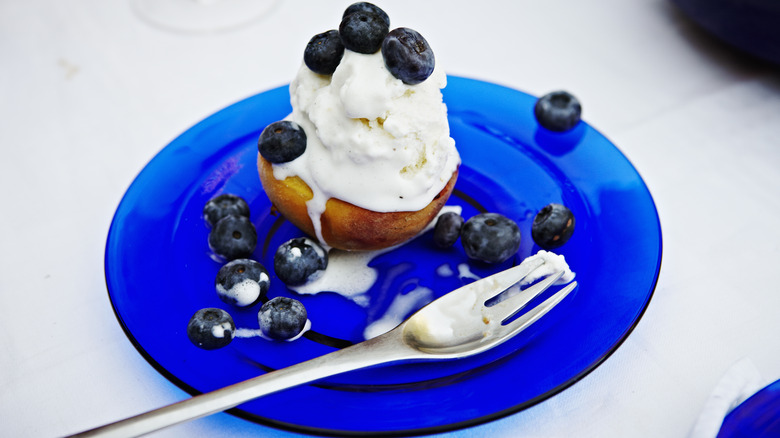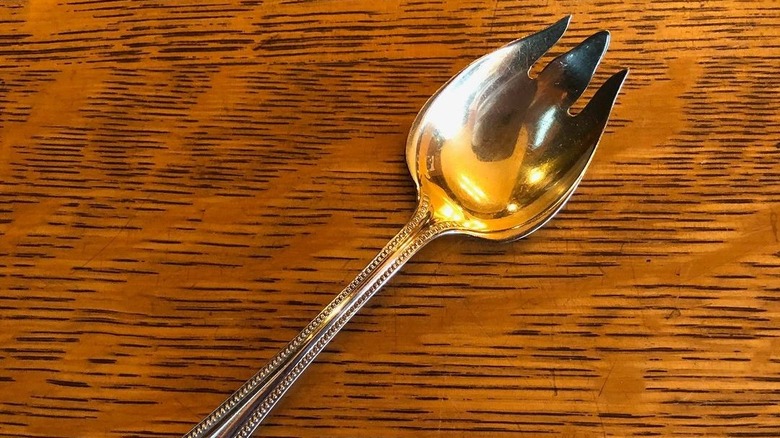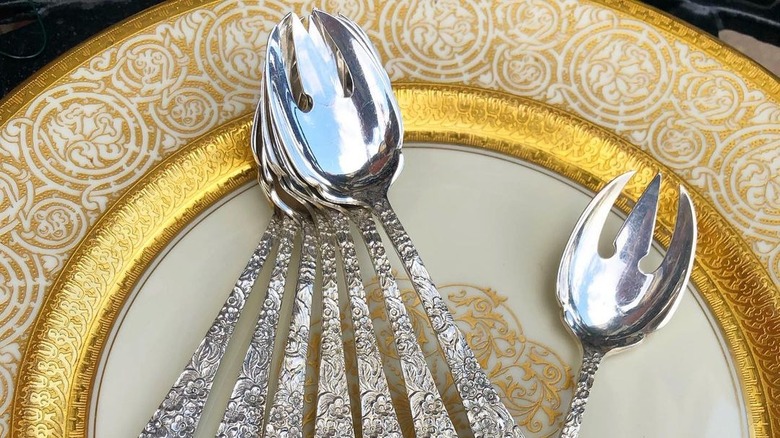Why You Need An Ice Cream Fork And Where You Can Buy One
Nowadays, people usually eat ice cream with a spoon, whether they're eating a few scoops out of a nice bowl or eating it directly from the carton after a rough day. Spoons can be trouble, though. Compared to soft serve, ice cream has a thick texture because it contains more milk fat, and it's usually served colder. Both of these factors mean that, sometimes, ice cream can put up a fight against your spoon. And while spoons have trouble piercing tougher pints of ice cream, using a fork to eat the dessert is also difficult.
We used to have "ice cream forks" to solve this dilemma. During old Victorian banquets, it was common to see pronged utensils with a small dip in the center, perfect for breaking through ice cream's frozen shell and scooping out the treat to eat. Nowadays we call them sporks, and while they are often disposable and made from flimsy plastic, a sturdy enough spork can easily pierce thick ice cream and contain it long enough to make it to your mouth. There was a time in history when eating ice cream this way was considered very fancy, and you might consider trying it yourself.
Where to buy an ice cream fork today
When it comes to the basic shape, there isn't any difference between ice cream forks and sporks. Ice cream forks are considered precursors to modern sporks, and they often had slightly fancier designs that we don't see in simple sporks today. Ice cream was popular during the Victorian era, and lots of popular desserts like ice cream sundaes and banana splits first popped up around this time (although ice cream sundaes were invented in America, not England). Whenever ice cream was served in 18th-century England, eating it with an ice cream fork was considered the proper method.
It's tough to find those old antique sporks, and they wouldn't be cheap if you did, but there are still modern, affordable ice cream forks on the market. They tend to be on craft sites like Etsy, but you can also just purchase a metal spork. If you can find a good quality spork made from titanium or aluminum, you'll have an acceptable ice cream fork substitute. If you want to justify your purchase of a fancy ice cream fork, you'll just have to eat ice cream often. Try mixing ice cream with alcohol before digging in, or make a lavish sundae mixed with cherries and pistachios.
The history of the Victorian-era ice cream fork
You could say there was an overabundance of cutlery in 19th-century England; rather than just spoons, forks, and knives, fancy dinners involved lots of specific types of cutlery for specific types of foods. While ice cream forks were meant to be served with dessert only, they bear a resemblance to other, similar types of antique cutlery like the terrapin fork, which has deeper indents (sometimes they look almost like a little trident) and is designed for taking bread out of bread baskets. Then you have the ramekin fork, which also has a slight bowl shape beneath its prongs, and was designed for eating out of ramekin dishes (small dishes meant for cheese or custards).
When ice cream forks transitioned into the more versatile, sillier-sounding sporks isn't completely clear. American inventor Samuel L. Francis patented a spork-like utensil in 1874, but the name "spork" became popular almost a century later, around 1970. This is when Van Brode Milling Co. started using the name to sell their spoon-fork hybrids. These sporks weren't quite so Victorian and high-brow, and they soon turned into the plastic mainstays in school lunches that we know and laugh at today.


